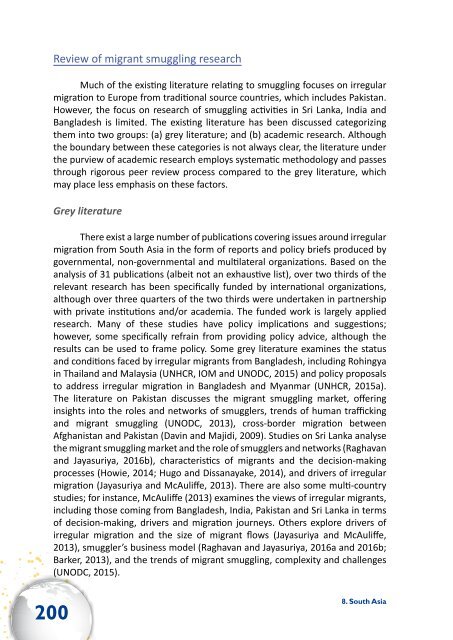Migrant Smuggling Data and Research
zgw9fv2
zgw9fv2
You also want an ePaper? Increase the reach of your titles
YUMPU automatically turns print PDFs into web optimized ePapers that Google loves.
Review of migrant smuggling research<br />
Much of the existing literature relating to smuggling focuses on irregular<br />
migration to Europe from traditional source countries, which includes Pakistan.<br />
However, the focus on research of smuggling activities in Sri Lanka, India <strong>and</strong><br />
Bangladesh is limited. The existing literature has been discussed categorizing<br />
them into two groups: (a) grey literature; <strong>and</strong> (b) academic research. Although<br />
the boundary between these categories is not always clear, the literature under<br />
the purview of academic research employs systematic methodology <strong>and</strong> passes<br />
through rigorous peer review process compared to the grey literature, which<br />
may place less emphasis on these factors.<br />
Grey literature<br />
There exist a large number of publications covering issues around irregular<br />
migration from South Asia in the form of reports <strong>and</strong> policy briefs produced by<br />
governmental, non-governmental <strong>and</strong> multilateral organizations. Based on the<br />
analysis of 31 publications (albeit not an exhaustive list), over two thirds of the<br />
relevant research has been specifically funded by international organizations,<br />
although over three quarters of the two thirds were undertaken in partnership<br />
with private institutions <strong>and</strong>/or academia. The funded work is largely applied<br />
research. Many of these studies have policy implications <strong>and</strong> suggestions;<br />
however, some specifically refrain from providing policy advice, although the<br />
results can be used to frame policy. Some grey literature examines the status<br />
<strong>and</strong> conditions faced by irregular migrants from Bangladesh, including Rohingya<br />
in Thail<strong>and</strong> <strong>and</strong> Malaysia (UNHCR, IOM <strong>and</strong> UNODC, 2015) <strong>and</strong> policy proposals<br />
to address irregular migration in Bangladesh <strong>and</strong> Myanmar (UNHCR, 2015a).<br />
The literature on Pakistan discusses the migrant smuggling market, offering<br />
insights into the roles <strong>and</strong> networks of smugglers, trends of human trafficking<br />
<strong>and</strong> migrant smuggling (UNODC, 2013), cross-border migration between<br />
Afghanistan <strong>and</strong> Pakistan (Davin <strong>and</strong> Majidi, 2009). Studies on Sri Lanka analyse<br />
the migrant smuggling market <strong>and</strong> the role of smugglers <strong>and</strong> networks (Raghavan<br />
<strong>and</strong> Jayasuriya, 2016b), characteristics of migrants <strong>and</strong> the decision-making<br />
processes (Howie, 2014; Hugo <strong>and</strong> Dissanayake, 2014), <strong>and</strong> drivers of irregular<br />
migration (Jayasuriya <strong>and</strong> McAuliffe, 2013). There are also some multi-country<br />
studies; for instance, McAuliffe (2013) examines the views of irregular migrants,<br />
including those coming from Bangladesh, India, Pakistan <strong>and</strong> Sri Lanka in terms<br />
of decision-making, drivers <strong>and</strong> migration journeys. Others explore drivers of<br />
irregular migration <strong>and</strong> the size of migrant flows (Jayasuriya <strong>and</strong> McAuliffe,<br />
2013), smuggler’s business model (Raghavan <strong>and</strong> Jayasuriya, 2016a <strong>and</strong> 2016b;<br />
Barker, 2013), <strong>and</strong> the trends of migrant smuggling, complexity <strong>and</strong> challenges<br />
(UNODC, 2015).<br />
200<br />
8. South Asia
















